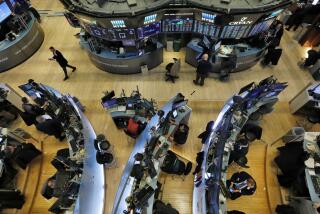Stocks rise after hiring surge but Dow misses 18,000

A strong jobs report boosted U.S. and European stocks Friday, and leaving the Dow Jones industrial average just short of the 18,000 mark.
The main focus in the markets was the monthly hiring numbers. The Labor Department said U.S. employers added 321,000 jobs last month, the biggest burst of hiring in nearly three years, while the unemployment rate remained steady at 5.8 percent.
Despite the good news, stock gains were restrained. Investors now expect the robust jobs growth — and other signs the economy is accelerating — could lead the Federal Reserve to raise interest rates sooner than anticipated.
Banks, whose profit margins increase when interest rates rise, were among Friday’s biggest gainers. Safety-focused utility stocks, which tend to perform poorly in an improving economy, were among the biggest decliners, along with energy companies, which were hurt once again as oil prices retreated.
With Friday’s modest increases, the Standard & Poor’s 500 index closed out a seventh-straight week of gains. The stretch was its best winning streak in a year and in stark contrast to the near-correction in the market only a month-and-a-half ago.
“We continue to see this steady drip into the equities markets, and I don’t think it’s going to stop any time soon,” said David Kelly, chief global strategist for J.P. Morgan Funds.
The Dow Jones industrial average rose 58.69 points, or 0.3 percent, to 17,958.79. The S&P 500 index rose 3.45 points, or 0.2 percent, to 2,075.37. The Nasdaq composite rose 11.32 points, or 0.2 percent, to 4,780.76.
November’s jobs report, as well as other positive economic data, could raise expectations among investors that the Federal Reserve will soon start raising interest rates. Last month marks the 10th straight month of job gains above 200,000, and would put 2014 on track to be the best year for hiring since 1999.
The yield on the benchmark 10-year U.S. Treasury note climbed to 2.31 percent from 2.24 percent the day before as investors sold bonds in anticipation of higher rates.
“The bottom line is this was yet another very solid employment report and another strong data point reaffirming the strength of U.S. growth versus a sluggish global (economy),” Rick Rieder, chief investment officer of fundamental fixed income at BlackRock, wrote in a note to reporters.
Investors like seeing a healthy U.S. economy, but are also aware that stock prices are higher partly because of ultra-low interest rates. If the Fed believes the U.S. economy is overheating, they would raise interest rates and it could cause stock prices to decline.
Not all stocks would be losers in a higher interest rate environment. Bank stocks rose Friday, with JPMorgan Chase, Citigroup, Bank of America, and Wells Fargo up 1 percent to 2.5 percent. Higher interest rates would allow banks to charge more for loans and would boost profits.
Still, the gains weren’t enough to push the Dow to another round-number landmark. Just five months after cresting the 17,000-point level for the first time, the Dow is on the verge of 18,000. The blue chips came within nine points of that figure Friday, before pulling back.
Still, the Dow’s performance this year has trailed the other major indexes. The average is up 8.3 percent in 2014, while the S&P 500, which is tracked more by mutual funds and Wall Street, is up 12.3 percent. The Nasdaq is up the most, rising 14.5 percent.
The price of oil fell Friday to its lowest level since July of 2009 on continued expectations of high global supplies and Saudi Arabia’s decision to cut its prices.
Benchmark U.S. crude fell 97 cents to close at $65.84 a barrel in New York. Brent crude, a benchmark for international oils used by many U.S. refineries, fell for the ninth time in the last 10 trading sessions, closing down 57 cents to $69.07 in London.
Energy stocks followed oil prices lower. Chevron fell $1.41, or 1.3 percent, to $110.87. Marathon Petroleum lost $4.52, or 4.7 percent, to $92.15 and Phillips 66 fell $1.95, or 2.6 percent, to $73.02.
Along with the improving economy, the drop in oil prices has been encouraging to investors. Lower oil prices, and in turn lower gas prices, are effectively a tax cut on the average U.S. consumer, and it could translate into higher consumer spending down the road.
The dollar rose against other currencies as traders anticipated more robust growth in the U.S. and higher interest rates.
The price of gold fell $17.30, or 1.4 percent, to $1,190.40 an ounce. Silver fell 32 cents, or 1.9 percent, to $16.26 an ounce. Copper slipped a penny to $2.90 a pound.






